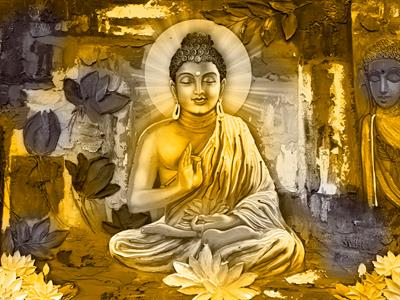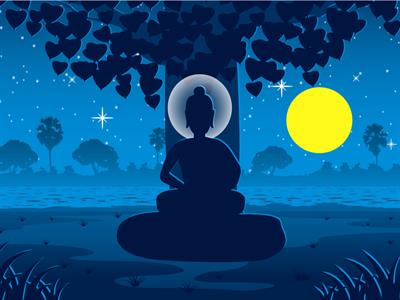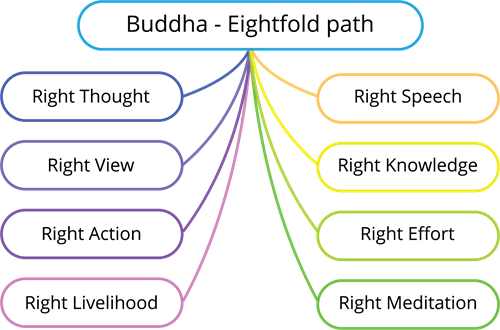
PUMPA - SMART LEARNING
எங்கள் ஆசிரியர்களுடன் 1-ஆன்-1 ஆலோசனை நேரத்தைப் பெறுங்கள். டாப்பர் ஆவதற்கு நாங்கள் பயிற்சி அளிப்போம்
Book Free DemoThe Birth of Gautama Siddhartha:
The Royal Prince of the Sakhya clan was born in Lumbini in the year \text{563 BCE}. His real name was Siddhartha who later acquired the name Buddha and was credited as the founder of Buddhism.
After losing his mother Mayadevi, seven days post his birth, he was raised by his stepmother Gautami. Gautama married Yasodhara and led a normal Prince in Lumbini.

Buddha
He renounced his prince-hood at an age of 29, where the incidents he witnessed at this age shocked his existence. He left his family and embraced Sainthood.

The sightings of these incidents gave Gautama a rude shock while he was taking stock of his empire. He was highly attracted to the emotional balance of the ascetic which influenced him to detach himself from worldly attachments.
The Enlightenment Phase:
After renouncing his princely life Gautama embraced the life of an ascetic who believed in attaining supreme knowledge through meditation.

The Enlightened Buddha
Gautama sat under the “Pipal tree” and undertook rigorous meditation which brought him the desired result of “Enlightenment” during his 49^{th} day of the Meditation.
Gautama Buddha: He attained the Enlightenment under the Pipal tree located in Bodh Gaya (Bihar) on the banks of the river “Niranjana”.
He discovered the truths of life through the process of meditation which made him a noble soul. After attaining the Enlightenment, he was known by the name of “Buddha – the Enlightened one”.
Also, Buddha spread the truths that he acquired during his meditative state to enlighten people who survived under the veil of ignorance.
These tenets of Buddha later came to be known as the Noble truths, as they are universally appealing among the masses.
Four Noble Truths Of Buddha
1. Life in the world is full of Sorrow and Misery.
1. Life in the world is full of Sorrow and Misery.
2. Desire is the root cause of all miseries.
3. Suffering of oneself can be erased if they give up their desire.
4. The Desire can be conquered by adopting the Right path (Eight-fold Path)
Buddha’s Eight-Fold Path:
Buddha firmly believed that the desire of humans was the ultimate cause of their sufferings and regrets. So to root out the sufferings of one’s life one should be able to exert control over the desires.
The teachings of Buddha were done in languages that are used by the common people like Prakrit so that they can reach the roots of the society. This nature of Buddhist teachings took the religion closer to the people of lower strata.
Buddha advocated Eight truths that spoke about Conduct, Knowledge and meditation. He also called for the rejection of sacrifices and rituals.

Buddhism and its Literature:
The teachings of Buddha were taken to the People through the language which they can easily understand and interpret, so the disciples and other teachers of Buddhism used the Pali language to Preach the ideals of Buddhism.
Most of the teachings were done by Oral means, post the death of Buddha the canon of Buddhism was written down in the 1^{st} and 2^{nd} Centuries.
Important among Buddha’s teachings were the Pitakas, which are three as following:
1. Sutta Pitaka: It contains 10,000 Sutras which are related to Buddha and his disciples, it also advocated the Principles that are to be followed by the religion with discourses. This Pitaka also speaks about the “First Buddhist Council” which took place after the death of Buddha.
2. Vinaya Pitaka: This book is also known as the Book of Discipline, which deals with the monastic rules that have to be followed by the Monks and Nuns to achieve purity of Souls.
3. Abhidhamma Pitaka: It is the last of the Tripitakas, which speaks about Philosophy, ethics and the doctrine of Buddhism.
Prominent Buddhist Literary texts:
The Buddhist literature is vast as it contains numerous literary sources which enabled Historians to explore the religion. Some of them are discussed below.
1. The Jataka Tales:
The Jataka Tales comprises songs and texts which briefly deal with the Previous births and lives of Buddha.
2. Milindapanha:
This Buddhist Literature was written in Sanskrit which deals with the conversation between a Buddhist monk Nagasena and the Bactrian King Milinda. The name of this is “The Questions of Milinda”.
3. Dipavamsa and Mahavamsa:
These are Buddhist texts belonging to Ceylon which speaks about the connections that the Island nation had with Buddhism and its scholars.
Dipavamsa means the “Island Chronicle” which speaks about the arrival of Buddhist teachers and their preaching in Ceylon. It was written in Pali Language.
Mahavamsa means “Great Chronicle” which is a Poem written in the Pali language which deals with the royal dynasties and Kings of Ceylon.
4. Buddhavamsa:
This literary text speaks about the predecessors of Gautama Buddha who are 24 in number and their role in making Buddha attain Sainthood. It contains 29 sections of Verses.
5. Visuddhimagga:
Visuddhimagga text was written by Buddhagosha who belonged to the Theravada form of Buddhism. He is also the First Buddhist commentator. The text Visuddhimagga means “Path to Purification”.
6. Buddhacharita:
It was written by Ashvagosha in the Sanskrit language. This book deals with the primary life of Buddha and his early days. Sanskrit literature flourished during the reign of rulers who followed Mahayana Buddhism.